Where Do the Light Reactions Occur in the Chloroplast
What is chloroplast?
Thechloroplast is a double membrane cell organ recovered in plants and certain algae cells. The main function of the chloroplast is to convert energy from the Sun into chemical Energy (glucose) for maturation, a work called photosynthesis. This is why we call chloroplasts are like solar panels inside the cells.
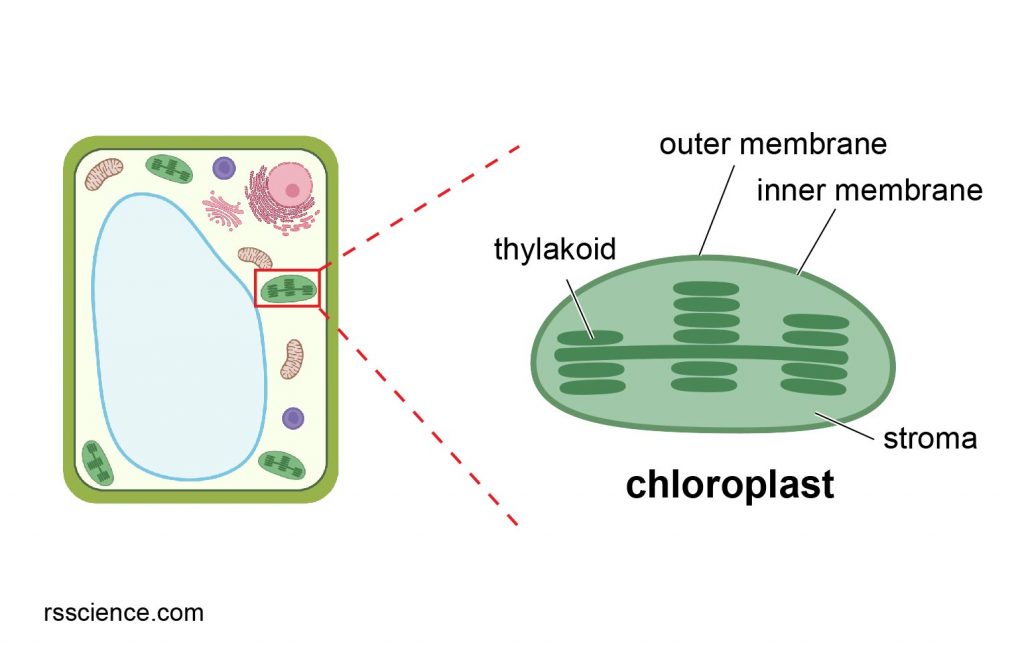
[In that fles] The chloroplast and its relative location inside the plant cells.
The structure of chloroplasts
Inside the chloroplast space besieged away inner membranes, on that point is a protein-rich fluid called the stroma, which corresponds to the cytosol of the original cyanobacterium. Chloroplast DNA, ribosomes, starch granules, and many proteins can be found floating in the stroma.
Suspended inside the chloroplast stroma is the thylakoid system. Thylakoids are membranous sacks containing chlorophyll molecules and are where the light reactions of photosynthesis encounter. In nigh tube plants, the thylakoids are artificial in loads called grana (singular: granum). However, in certain C4 plants (like rice) and some algae, the thylakoids are free-floating.
The dozens of thylakoid sacs are related to by stroma lamellae. The lamellae act similar the frame of the chloroplast, holding all of the sacs at a safe distance from each other and maximizing the efficiency of the cell organelle. If all of the thylakoids were overlapping and bunched together, there would not make up an efficient style to capture the Sun's energy.
The size of chloroplasts is roughly 1–2 μm thick and 4–6 μm in diameter[1].

[In this figure] Transmitting electron micrographic image of chloroplast and its construction.
[Socialistic] The thylakoid (dark region) is the area where photosynthesis happened. They are connected by stroma lamellae. Some dark spots around the stroma are lipid.
Photo source: varied from University of Wisconsin-Madison Libraries
Where is the chloroplast located in a cell
The chloroplast is placed throughout the cytol of the cells. They can often comprise found in the plant leave behind cells, defend cells (specialized cells to control gas convert), and cells of the party tissue of the plants. In fact, the reason we see plant green is payable to the chloroplasts.
Chloroplast social movement
Chloroplasts are motile: they move contingent on the availableness of sunlight.
Low the shade conditions, chloroplasts go on to the area where they can absorb A a good deal Light Within as possible. When the light is strong such as the full sun, chloroplasts move from the electric cell aerofoil to a side wall where they can minimize photodamage. In the dark, chloroplasts migrate to the bottom of cells, although the purpose of this movement in the dark is not clear[5].
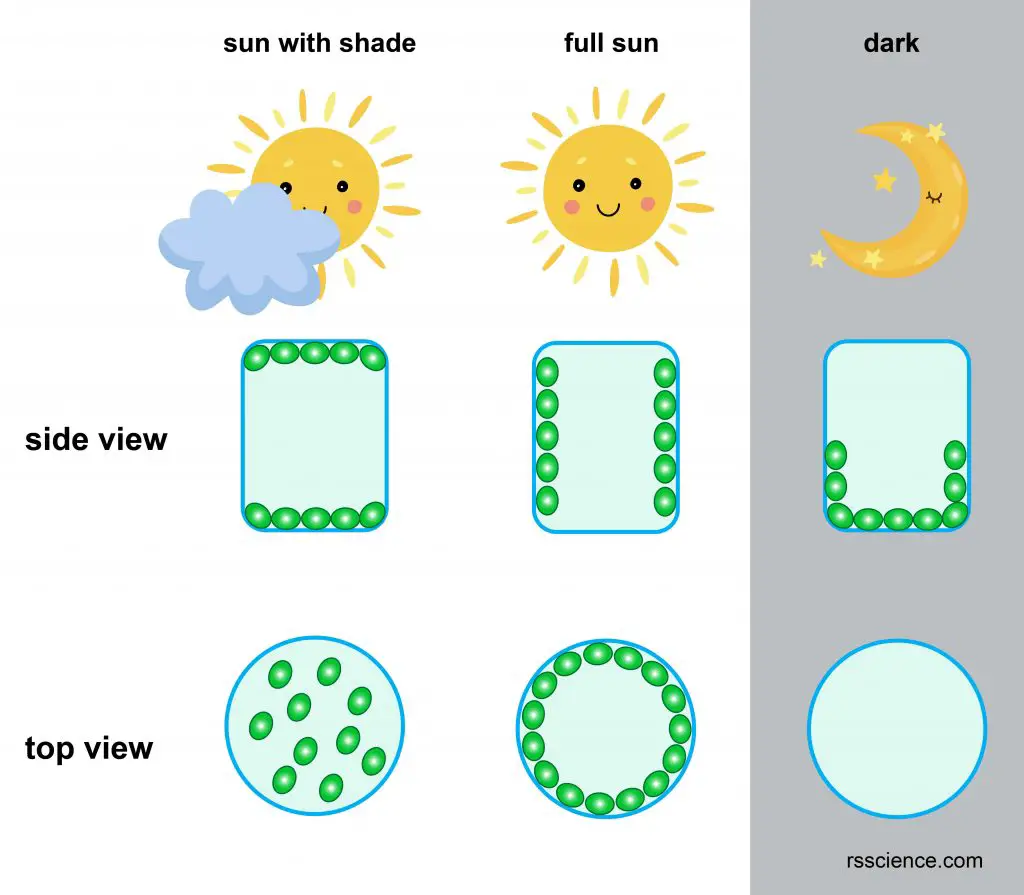
[In this figure] Chloroplast bm in different conditions.
The location of chloroplasts in the side eyeshot and top eyeshot are shown. In the shade condition, chloroplasts move to the lieu where IT can absorb every bit a good deal light A possible. In the orotund sun condition, the chloroplasts avoid the sun, minimize the photodamage. In the dark, the chloroplasts stay at the bottom of the cells.
Cytoplasmic streaming
Cytoplasmic streaming is a movement of the fluid cytol within a cell. You can often see chloroplasts move on the cell walls.
Catch out more virtually cytoplasmic moving, delight check "what is cytoplasmic streaming".
[In this telecasting] Looking at at chloroplasts tossing by cytoplasmic streaming in plant cells (Elodea) – DIC microscope/ 1250x.
How more chloroplasts can be found in one cell?
The number of chloroplasts per cell ranges from 1 to 100 per cubicle, contingent on organisms. Chlamydomonas reinhardtii is a undivided-electric cell green alga that contains a azygos large cup-shaped chloroplast.
Chlamydomonas is an grave model organism because we can manipulate its genetics and cultivation them easily. Interestingly, we can modify not only the central genome of Chlamydomonas, simply also its chloroplast genome. This provides a great tool to understand the role of nuclear genes in chloroplast factor face and chloroplast biosynthesis.
Else plants, such as Genus Arabidopsis thaliana, contains ~ 100 chloroplasts per epidermal cell. Coffea arabica has 13-20 chloroplasts per safety device electric cell, so information technology really depends connected the species[2-4].
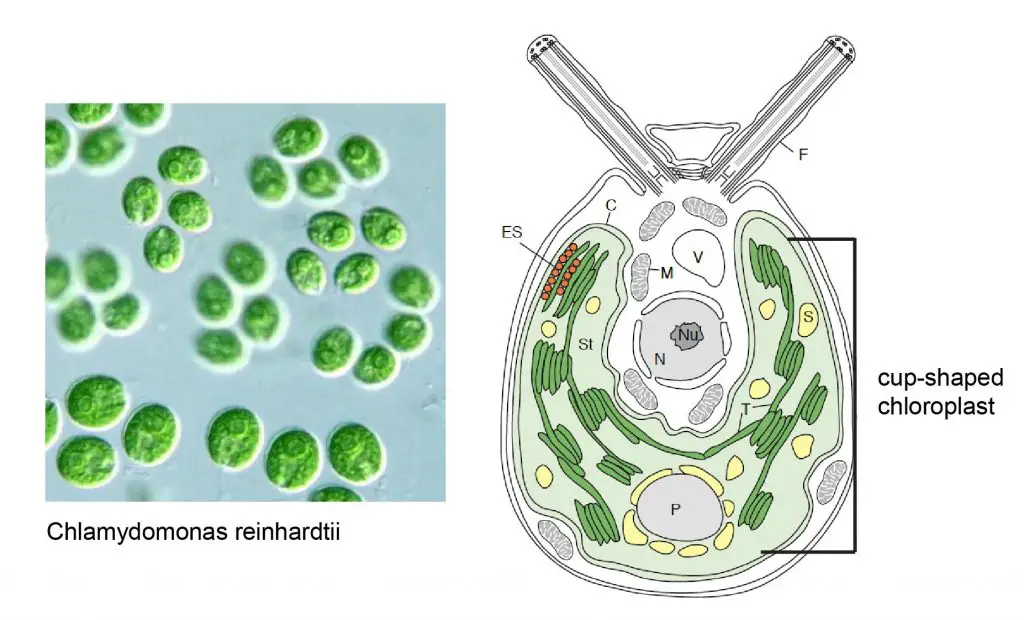
[In this figure] Chlamydomonas reinhardtii and its cup-molded chloroplast.
Left field is the image of Chlamydomonas, and right is the illustration of organelles in Chlamydomonas. Thylakoid membranes (T) and starch grains (S) within the stroma (St).
Exposure source: modified from Alchetron and Trends in Plant Science.
What is the biological function of chloroplast?
Chloroplasts convert the light energy of the Sun into sugars (a treat called photosynthesis) that can glucinium used past cells. At the same time, photosynthesis produces oxygen (O2) and consumes carbon dioxide (CO2). For this reason, plants are the basis of all life on Earth. They are classified as the producers of the world.
Chloroplasts also ply diverse functions for constitute cells, including fatty acids synthesis, aminoalkanoic acid synthesis, and implant innate resistance.
Photosynthesis
Chlorophyll is a little green molecule seated on the surface of each thylakoid sacs and is the core of photosynthetic reaction. When the Energy from the Sunshine hits a chloroplast and its chlorophyll molecules, light energy is converted into the chemical energy found in compounds so much as Adenosine triphosphate and NADPH. This part is called calorie-free-dependent reactions. It happens in a series of electron transportation between protons crosswise the membrane, which is similar to what we antecedently described in mitochondria.
Later, these muscularity-rich compounds move into the stroma where enzymes fix the atomic number 6 atoms from carbon dioxide (CO2) to synthesize sugar molecules. This divide is called the Jean Chauvin cycle operating room dark reactions. O (O2) is a byproduct of this chemical reaction. Plants and animals then use the sugars (glucose) for food and energy (plant cells receive mitochondria, too).
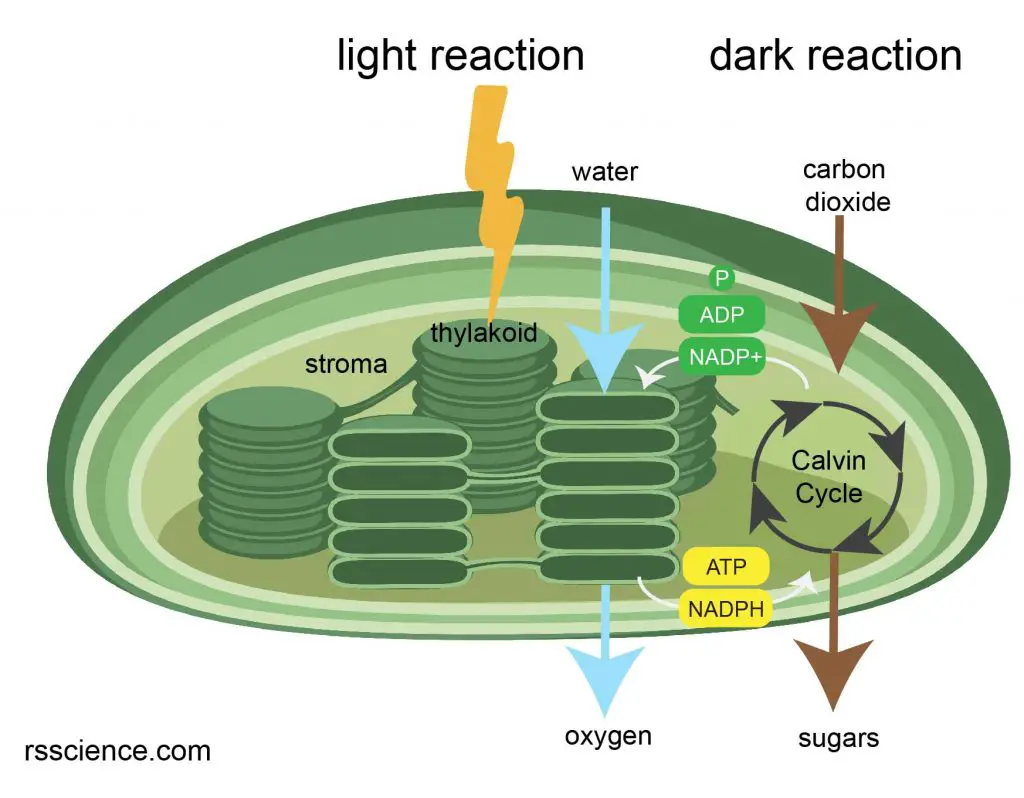
[In this figure] Illustration of photosynthesis.
Chlorophylls in the thylakoid absorb the energy from the Sunlight and transfer the energy to ATP and NADPH. In the dreary reaction, the enzymes and proteins in the stroma utilisation high energy molecules such as ATP and NADPH to convert carbon paper dioxide to sugars.
Innate immunity
Unlike animals, plants do not have immune cells (white blood cells). Each cellphone has to support itself. Plants have two immune response, hypersensitive reaction and systemic gain resistance.
Hypersensitive response
When pathogens are present in a mobile phone, the cell seals itself off and undergoes apoptosis (a programmed cell death). This can forestall the pathogen from spreading to other cells.
Systemic acquire resistance
The infected cells can also release signals to inform the rest of the plant cells that the pathogens are inst. Therefore, the rest of the plant cells can prepare for the defense.
The chloroplast is a key player for 2 immune responses. Chloroplast can designedly terms their chemical process system of rules to produce reactive oxygen species (ROS), which tooshie directly kill pathogens (bacterium) within the cells. Jolly much like the mechanism by which macrophages employ ROS to kill bacterium in humans. The residual (low level) of ROS serves as an "SOS" signalize and trigger defense molecules production in the rest of the plant cells.
How does the chloroplast divide?
In single-cubicle algae, they often rich person ace chloroplast; hence, the chloroplast replicates and divides before the cytokinesis windup.
Land plant cells broadly speaking have many chloroplasts. Their chloroplasts divide according to the cell's need, not ever twin with cadre division. Divers state of affairs stimuli dissemble the chloroplast division rate. For example, the chloroplasts divide and increment their number when the cell grows bigger[6].
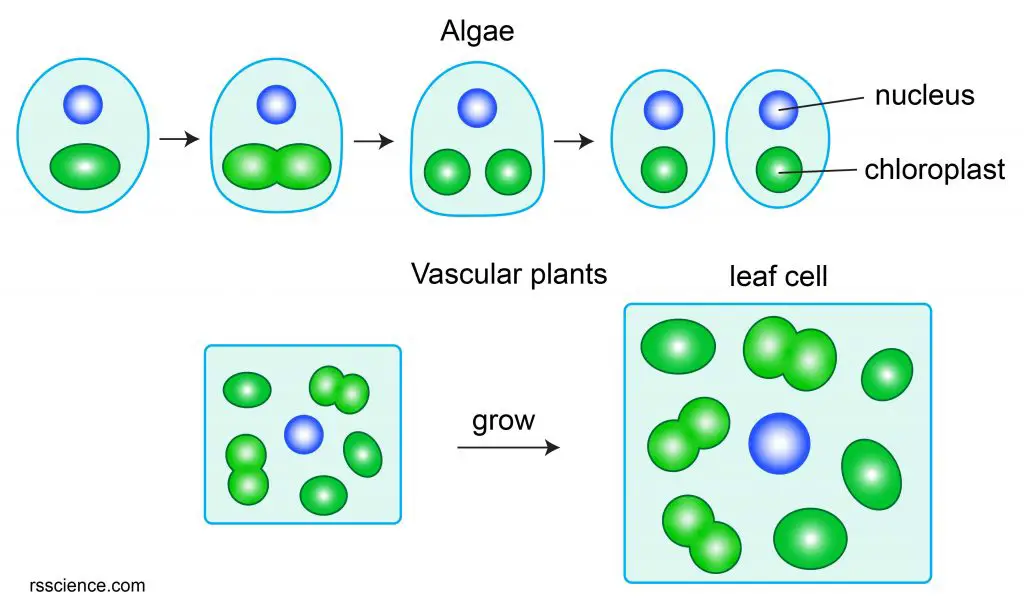
[In this fles] Chloroplast division in algae and vascular.
Lonesome-cell algae often take up unitary or a few chloroplasts. Chloroplast division occurs every cell cycle rightfield before the interval of two daughter cells (cytokinesis). In vascular plants, during the leaf development, the cadre division stops, but the nuclear DNA replication still continues, subsequent in the bigger nuclei and cells. During this time, the chloroplast division continues without cell division, subsequent in an increase of the chloroplasts in size and number.
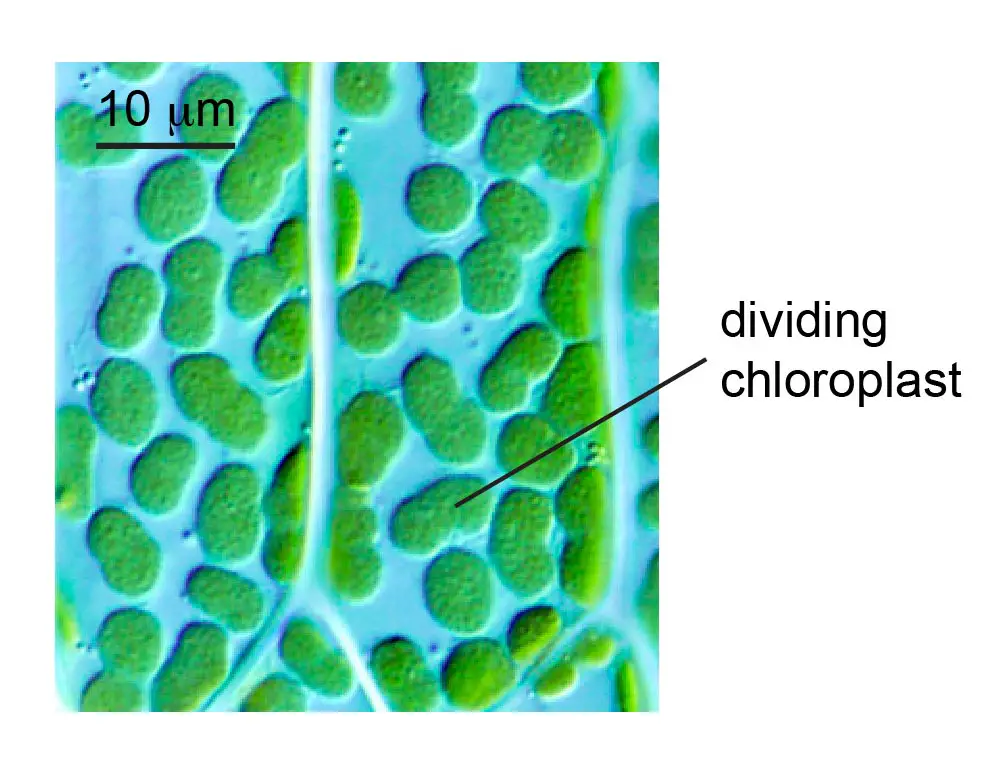
[In this figure] Dividing chloroplasts in the moss P. patens.
Exposure source: Found physiology
Chloroplast division process
The division process starts when the division proteins assemble into a ring structure (Z-ring) within the chloroplast stroma. Next, the two plastid-disjunctive rings (PD rings) form along the z-encircle. And then the chloroplast constriction begins.
Next, dynamin proteins (motor protein) assemble around the Pd ring, providing force to compact the chloroplast. As the chokepoint site becomes narrower and narrower, two chloroplasts separate[7].
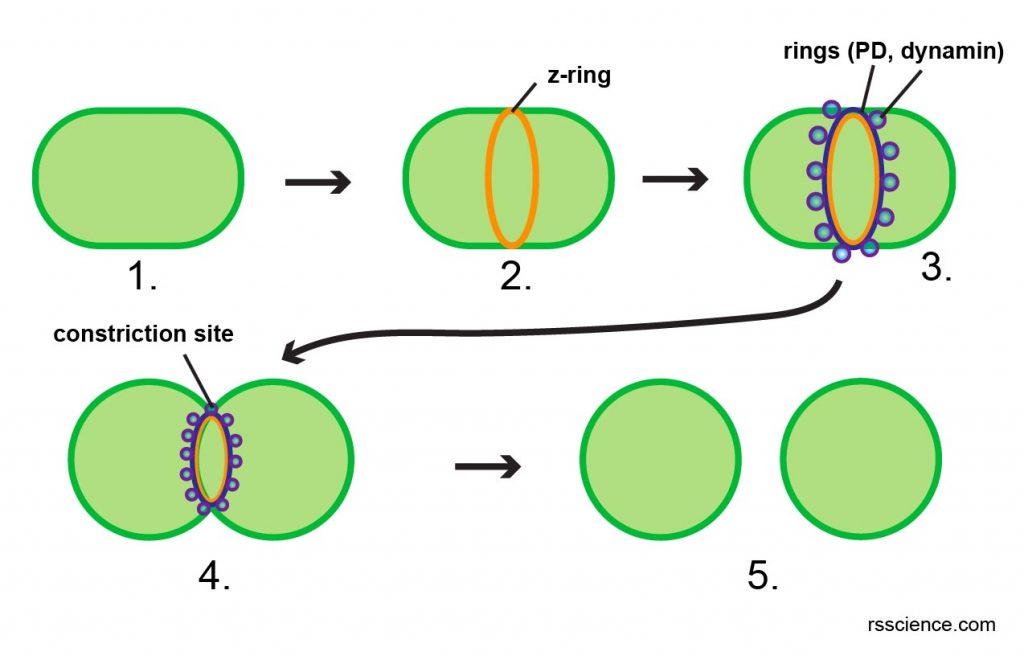
[In this figure] Cartoon diagram showing the chloroplast division steps.
Naval division machinery such as protein convoluted assembles into a ring structure (2 and 3). These ring structures apply forc to narrow the constriction site (4). Then, the chloroplast completes the division, and two daughter cells human body (5).
The origin of chloroplasts – the endosymbiotic theory
Chloroplasts and mitochondria share some in average. Both organelles take in two layers ofmembranes – titled outer and inner membranes. Chloroplasts and mitochondria also have their own copies ofDNA, which are independent of the cell nuclei. At that place are specializedribosomes inside chloroplasts and mitochondria to make proteins solitary for these organelles. Scientists believe chloroplasts and mitochondria are derived from the bacteria that were enveloped by the new ancestors of today's eukaryotic cells. This theory is titled theendosymbiotic hypothesis.
More or less 1.5 billion years ago, some prokaryotes incorporate another prokaryotes into their cells. These merged prokaryotes then lost their ability to live severally and become integrated as part of the hosts. They future became differentiated in specific functions, such as Energy production in both mitochondria and chloroplasts.
Mitochondria come out to be attendantRickettsiales proteobacteria, and chloroplasts appear to personify accompanying to organic process filamentous cyanobacteria. This endosymbiotic theory can explain wherefore chloroplasts and mitochondria have ii layers of tissue layer, their own Desoxyribonucleic acid and ribosomes.

[in this figure]Overview of the cognitive operation of endosymbiosis.
Photo cite: BioNinjia
Can animals live suchlike plants?
Elysia chlorotica (common discover the southeastern emerald elysia) is one of the "solar-powered deep-sea slugs", utilizing solar energy to generate vigour. The sea slug eats and steals chloroplasts from the alga Vaucheria litorea. The sea slugs then comprise the chloroplasts into their own digestive cells, where the chloroplasts bear on to photosynthesize for up to nine months – that's even longer than they would perform in algae.
The sea slugs stay nourished thanks to the sugars produced by photosynthesis. In the past, how this animal managed to do this was a complete mystery.
In a new canvass appearing in the Biological Bulletin[9], researchers reveal that the sea bullet has united genes from the algae that it eats. These genes, which encode for both chloroplast proteins and chlorophyll synthesis, are transferred from algae to the sea slug's chromosomes thusly that the purloined chloroplasts can beryllium well preserved for a long time.
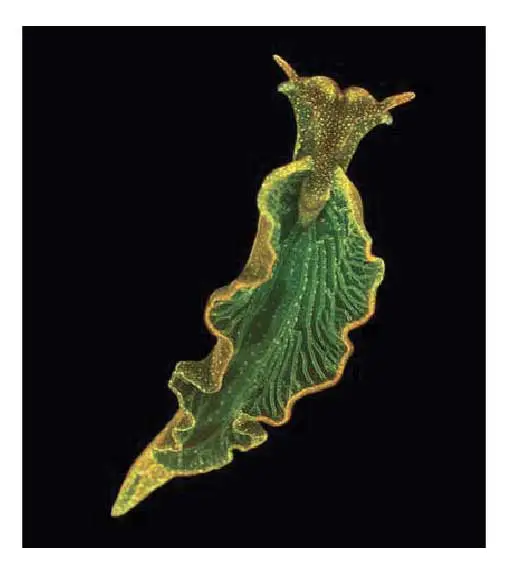
[In this figure] Elysia cholorotica, a sea bullet found off the U.S. Eastmost Coast, can buy photosynthetic chloroplasts from algae.
Photo source: Mary S. Tyler/PNAS
How to see the chloroplast under a microscope
The material you need
- Dummy microscope slides and coverslips
- Forceps
- Elodea or leaves (the thinner, the finer)
Steps
- Clean a slide with a piece of Kimwips paper.
- Add a drop of water supply happening the slide.
- Cut a small piece of Elodea leaves and put on the slide.
- Place a coverslip happening top. Lower the coverslip slowly with an tip. Reserve unrivaled side of the liquid droplet touches the coverslip first. This permits air to escape from the other side. You derriere usage the forceps to help you restraint the coverslip.
- The slides are ready for viewing.
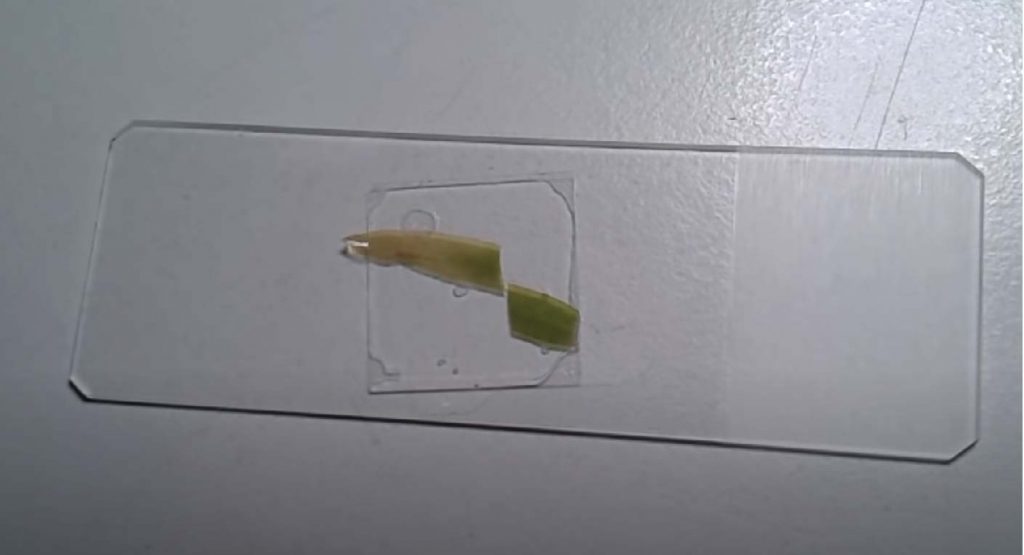
[In this figure] Place a spell of rif or elodea on the slide.
Cover with a coverslip. The slide is fix for wake.
What testament you see
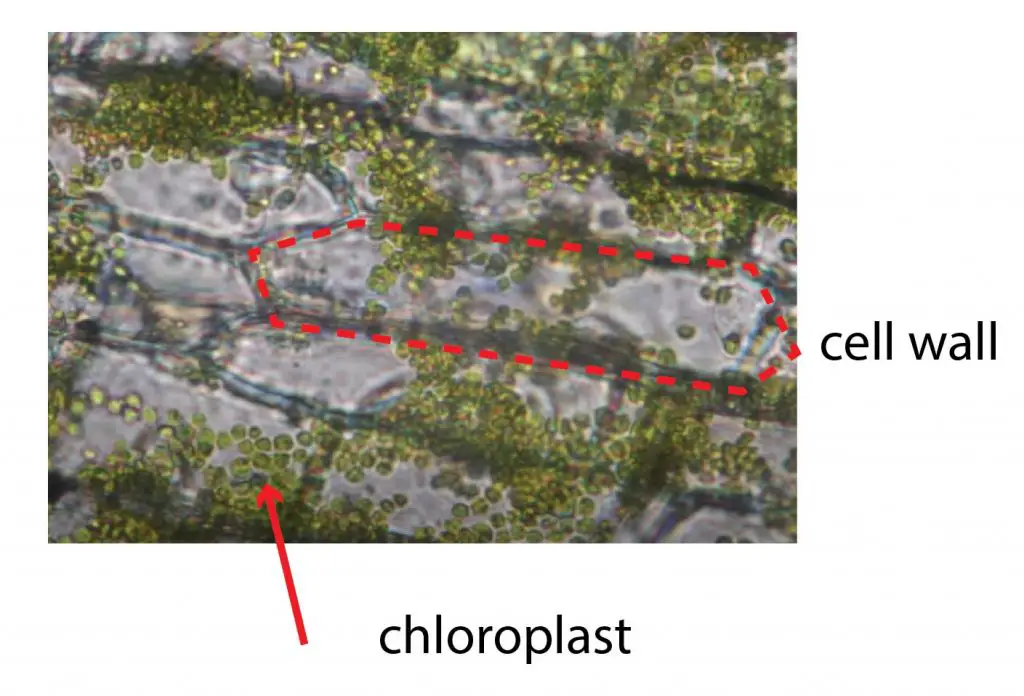
[In this figure] The chloroplasts under a unhorse microscope.
You can see individual cadre walls and many green chloroplasts. These chloroplasts go!! You may need to use higher magnification to see these movements.
Summary
- Chloroplasts are organelles that conduct photosynthesis and bring about Energy Department for the plant cells.
- Chloroplasts consist of many stacks of sac structures, known as thylakoid system. Chlorophyl in thylakoid absorbs the energy of the Sun and finished a series of reactions to produce sugar. At the same time, the reaction produces atomic number 8 (O2) and consumes carbon dioxide (CO2).
- Chloroplast plays an portentous role in plant naive resistance.
- Chloroplasts are motile; they move according to the light condition.
- Chloroplasts and mitochondria share many in common. They both have two layers of membranes, their ain DNA and ribosomes. They are believed to be derived from endosymbiotic bacteria engulfed by the early ancestors of today's being cells.
Reference
- http://book.bionumbers.org/how-large-are-chloroplasts/
- https://bionumbers.hms.John Harvard.edu/lookup.aspx?trm=chloroplast
- Königer M, Delamaide JA, Marlow ED, Townsend Harris GHz. Arabidopsis thaliana leaves with altered chloroplast numbers and chloroplast movement exhibit impaired adjustments to some low and high light. J Exp Bot. 2008 59(9):2285-97. p.2288
- Etienne H, Bertrand B. Trueness-to-type and agronomic characteristics of Coffea arabica trees micropropagated by the embryogenic cell hiatus proficiency. Tree Physiol. 2001 Sep21(14):1031-8. p.1034 table 2
- Wada M, Kong SG. Actin-mediated movement of chloroplasts. Journal of Cell Scientific discipline 2018 131: jcs210310
- Miyagishima SY. Mechanism of Plastid Division: From a Bacterium to an Organelle. Plant Physiol. 2011 Apr; 155(4): 1533–1544.
- wiki-chloroplast
- Bozeman Science
- Rumpho ME et al. Level cistron shift of the algal nuclear genepsbO to the photosynthetic seafaring stagnateElysia chlorotica. Proc Natl Acad Sci USA. 2008 Nov 18;105(46):17867-71
Kindred posts
Cell Biological science on the Board – Plant Prison cell Model
Cell Organelles and their Functions
Where Do the Light Reactions Occur in the Chloroplast
Source: https://rsscience.com/chloroplast-function-and-structure-solar-panels/
0 Response to "Where Do the Light Reactions Occur in the Chloroplast"
Post a Comment